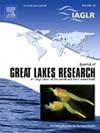Effects of river floods and sedimentation on a naturally dynamic Great Lakes estuary
IF 2.4
3区 环境科学与生态学
Q3 ENVIRONMENTAL SCIENCES
引用次数: 0
Abstract
Some of the most biologically diverse coastal wetlands and estuaries are found along the Great Lakes, but the spatial extent and timing of river-related inundation and sedimentation vary greatly among natural and altered systems. We used hydrologic data, geomorphic change detection, and satellite imagery to study inundation and sedimentation patterns in the naturally dynamic estuary of the Bad River (Mashkiiziibii) that flows into Lake Superior (Anishinaabeg-gichigami), and the Kakagon River (Ogaakaagaang-ziibii) that flows into a sheltered bay (Chi-Kaamigong). In 2016, an extreme summer flood (annual exceedance probability < 0.2 %) caused total inundation of the 46-km2 estuary. Floods from the sediment-rich Bad River, with an annual exceedance probability of ≤ 50 %, have overflowed into the upper wetlands and channels of the Kakagon River about 60 times over the last 75 years, including 20 floods during the most recent 10-year wet period. Sedimentation patterns were associated with proximity to river channels, shoreline erosion, and wind action. Early winter ice-up coupled with a storm surge and an early spring snowmelt into the iced-over bay changed inundation duration and sedimentation patterns. Climate-change projections for more intense rainfall and warmer temperatures will likely cause more frequent flooding and sedimentation; however, patterns may differ depending on the timing of the floods relative to storm surges and ice formation, or other factors. The approach of integrating readily available data helped give a broader temporal and spatial context to the possible causes for inundation and sedimentation, some expected and others not, in natural and restored estuaries of the Great Lakes.
河流洪水和沉积对自然动态的五大湖河口的影响
在五大湖沿岸发现了一些最具生物多样性的沿海湿地和河口,但与河流有关的洪水和沉积的空间范围和时间在自然和改变的系统之间差异很大。我们利用水文数据、地貌变化检测和卫星图像研究了流入苏必利尔湖(anishinaab贝格-gichigami)的巴德河(Mashkiiziibii)和流入庇护湾(Chi-Kaamigong)的卡卡贡河(Ogaakaagaang-ziibii)的自然动态河口的淹没和沉积模式。2016年夏季极端洪水(年超过概率<;0.2%)造成46平方公里的河口总淹没。在过去的75年里,来自富含沉积物的巴德河(Bad River)的洪水以每年不超过50%的概率向卡卡贡河(Kakagon River)的上游湿地和河道泛滥了大约60次,其中包括最近10年湿润期的20次洪水。沉积模式与靠近河道、海岸线侵蚀和风的作用有关。初冬结冰,加上风暴潮和早春融雪进入被冰覆盖的海湾,改变了淹没时间和沉积模式。对气候变化的预测表明,更强的降雨和更高的温度可能会导致更频繁的洪水和沉积;然而,模式可能会因洪水发生的时间与风暴潮、结冰或其他因素的关系而有所不同。综合现有数据的方法有助于在更广泛的时间和空间范围内了解五大湖自然河口和恢复河口发生洪水和沉积的可能原因,有些是预料到的,有些是预料不到的。
本文章由计算机程序翻译,如有差异,请以英文原文为准。
求助全文
约1分钟内获得全文
求助全文
来源期刊

Journal of Great Lakes Research
生物-海洋与淡水生物学
CiteScore
5.10
自引率
13.60%
发文量
178
审稿时长
6 months
期刊介绍:
Published six times per year, the Journal of Great Lakes Research is multidisciplinary in its coverage, publishing manuscripts on a wide range of theoretical and applied topics in the natural science fields of biology, chemistry, physics, geology, as well as social sciences of the large lakes of the world and their watersheds. Large lakes generally are considered as those lakes which have a mean surface area of >500 km2 (see Herdendorf, C.E. 1982. Large lakes of the world. J. Great Lakes Res. 8:379-412, for examples), although smaller lakes may be considered, especially if they are very deep. We also welcome contributions on saline lakes and research on estuarine waters where the results have application to large lakes.
 求助内容:
求助内容: 应助结果提醒方式:
应助结果提醒方式:


